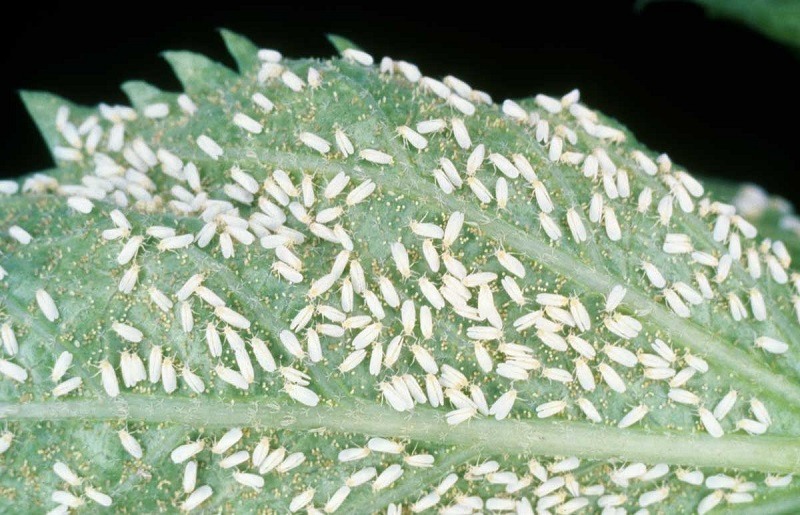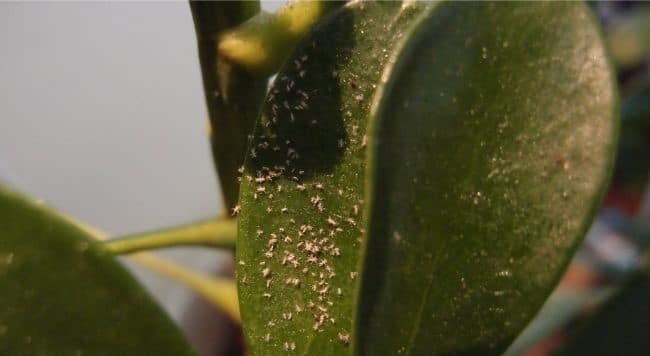I have been into indoor and outdoor gardening for over a decade now. White mites on plants have been my worst nightmare throughout the period. These tiny white bugs that look like dust can be challenging and intimidating to eliminate.
There is limited information about how to get rid of white mites on plants naturally over the internet. Most pests companies offer removal of white mites in homes only since they use harsh chemicals that might damage your crops.
I wrote this guide to help you identify white mites on houseplants and learn about the natural methods of eliminating them. I recommend using the same ways to get rid of white mites in the kitchen or bed.
What Are White Mites?
White mites are tiny clear-white bugs that infest houseplants and outdoor plants. These creatures feed on the foliage sap to cause wilting and yellowing. White mites are also known as spider mites or wood mites.
These tiny bugs that look like dust can also infest the kitchen and bed. Spotting these white arachnids can be tricky with naked eyes. The strands of silky web dangling from leaves make it easier to identify them.
Spider mites have a translucent clear-white oval body, tiny legs, and two antennae. A heavy white mite infestation can damage precious houseplants and crops since they pierce the leaves and stem to suck the plant juice.
Houseplants infested with white mites experience leaves turning yellow and brown. Severe spider mites infestation will result in complete defoliation. Keep reading this article to learn about white mites on plants removal tricks.
What Do White Mites (Spider Mites) Look Like?

White mites have a translucent clear-white oval body with a distinctive pair of dark spots on the rear end of their body. These minuscule bugs look like a grain of salt with an average size of 0.4mm.
Spotting these white arachnids with naked eyes can be a daunting experience. The magnifying lens will help notice eight spiny legs and a tiny head. The dark stripes on the inside edge of its body are prominent features for identifying these white bugs.
If you notice tiny red dots moving around or underneath the houseplant leaves, it is a sign of red spider mites. Both white and red mites are spider mites species that belong to the Arachnida class during the classification process.
The white mite’s life cycle starts as a tiny white pearl-shaped egg that hatches into a microscopic larva with six legs. The microscopic larva moves into the nymph stage and develops another pair of legs within 5-20 days to complete the life cycle.
An adult female white mite begins laying hundreds of eggs within four weeks. White mites multiply during hot and dry weather conditions. A female white mite will lay eggs every 12 hours, depending on the temperature, humidity, and plant type.
How to Identify White Mites (Spider Mites)
Spotting white mites on plants can be tricky with naked eyes. I recommend an up-close view of the plant for webbing and foliage damage evidence.
White mites spin silky webs around the stems and leaves. You will notice strands of dangling silky webs before spotting the spider mites.
Large webs dangling on the plant indicate severe white mite infestations. These tiny white bugs will also cause yellow and brown spots on the foliages.
White mites have mouthparts that pierce the leaves and suck out the juice. The venom injection makes the houseplant look speckled and develops stripped-pattern foliages.
Spider mites are more prevalent on houseplants under stress due to overwatering, over-fertilization, poor air circulation, and incorrect lighting conditions.
Tweaking the houseplant growing conditions will help prevent spider mite plant damage. Be sure to take an immediate white mites eradication action to avoid severe plant damage.
I recommend using a magnifying X10 lens to spot white mites on your houseplants. The tear-body shape with two black spots on the rear sides is a prominent identification feature.
The mite eggs also have spots around the leaf joints and underneath. Make it a routine to inspect the houseplant during the watering schedule.
Where Do White Mites (Spider Mites) Come From?
Spider mites can come from anywhere since there is no exact source. A newly-purchased infested plant is the leading source of white mites.
These tiny white bugs can also come from contaminated potting soil or houseplants that spend their summer outdoor. These white bugs are destructive if not controlled in advance.
I recommend buying new houseplants from reputable and reliable plant stores. These local garden centers usually spray their plants to eliminate any pests.
But white mites can infest outdoor plants or greenhouse crops during a dry and hot summer. It is inevitable to avoid these minuscule arachnids since they can be brought into the house by pets.
Develop the habit of inspecting your houseplants and crops more often to prevent severe infestations. I recommend investigating the houseplants and crops when watering them.
How to Get Rid of White Mites on Plants
Getting rid of spider mites on plants can be a daunting and challenging experience. The process begins by isolating the houseplant from others to avoid spreading.
Natural remedies to kill tiny white bugs on plants are reliable and efficient. These eradication methods are also environmentally friendly.
My favorite methods for eliminating white mites on plants are neem oil spray, insecticidal soap, and alcohol rubbing. They are eco-friendly and safe to use compared to pesticides.
Most pesticides are toxic chemicals and can make the white mites develop resistance. It will make it challenging to eliminate these tiny white bugs in the long run.
Below are the most effective and efficient methods to eliminate white mites on plants naturally and permanently:
Rubbing Alcohol to Eradicate White Mites
Rubbing alcohol is the most effective method for controlling tiny white bugs on plants. I recommend mixing equal parts of insecticidal soap, rubbing alcohol, and water.
Spray the plant whenever you notice signs of webbing or tiny white mites. Use the mixture for a few days until the white mite signs disappear.
Another excellent option is to soak a lint-free cloth in Isopropyl and wipe the infected leaves or stems. Rubbing alcohol eliminates the white mites on contact without damaging the plant.
Rosemary Oil Spray to Kill White Mites
Rosemary oil is a natural spray for eliminating white mites with miticidal activity. The natural oil spray is non-toxic to humans and pets.
The essential oil spray can kill two-spotted white mites from specific plants. Mix a teaspoon of high-quality rosemary oil with a quart of water and shake.
Spray the infected leaves to eliminate these tiny white bugs. Increase the rosemary oil concentration if the treatment seems ineffective.
Vinegar Spray to Eliminate White Mites
Vinegar spray can kill white mites on plants faster than other natural methods. Mix a quarter cup of vinegar with a quart of water. Add a teaspoon of baking soda and a few drops of dish soap.
Shake the mixture well and cover the leaves with the solution to eradicate all the white mites. I recommend spraying the plant until all the tiny bugs are eradicated.
Use Insecticidal Soap Spray to Eliminate the White Mites
It is a simple solution with properties that can eliminate white mites on the plants. It is a mixture of vegetable oil, pure liquid soap, and water.
Spray the infected houseplants with insecticidal soap to eradicate the tiny white mites. The best alternative is to dip a lint-free cloth in the solution and wipe the infected leaves.
The soap and oil will coat these tiny arachnids to cause a suffocation effect. The fatty acids will break down the mites and kill them.
Neem Oil Spray to Kill Tiny White Mites
A mixture of neem oil with castile soap and water is effective in killing white mites on houseplants or crops. Natural neem oil contains pests’ elimination properties.
Mix two teaspoons of neem oil with a teaspoon of castile soap and a quart of water. Fill the bottom spray and shake well before applying it to the plant.
Neem oil spray has a lethal effect on all mite species by disrupting their life cycle. The active ingredients have a repellent and suffocation effect.
Use Diatomaceous Earth to Control Spider Mites
It is a natural pesticide powder ideal for controlling spider mites on plants. The abrasive and dehydrating nature makes the component lethal to white mites.
Diatomaceous earth is safe for use in homes and around pets. I recommend wearing a protective mask when applying the powder to avoid inhalation.
Sprinkle the powder on the leaves and dry potting soil to eliminate the tiny white mites. Apply the powder to outdoor plants during dry weather conditions.
Shower the Plant to Remove Tiny White Mites
Rinsing the plant foliages with plenty of distilled water is a sure way to remove white mites. Place the houseplant in a bathtub and shower the leaves.
Hose the outdoor plants to remove the white mites and their eggs. The technique will also help eliminate other creatures damaging your plants.
Trim the Affected Leaves to Eliminate the White Mites
Pruning the affected leaves is the natural way of eliminating white mites on the plants. Trim the stems and leaves with silky webs, then discard them.
Be sure to treat the rest of the plant with a natural white mite spray. It will help remove all the eggs on healthy leaves or stems and prevent future occurrences.

Takeaways from White Mites on Plants
- Maintain high humidity around the plants to prevent white mite infestations.
- Inspect the plant more often for white mite webbings.
- Wipe the plant foliages more often to prevent tiny white mites.
You May Also Like:
